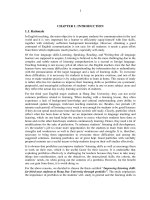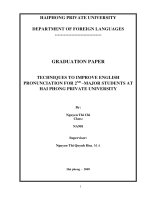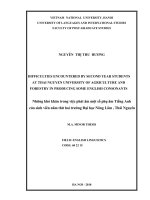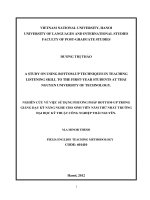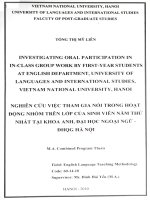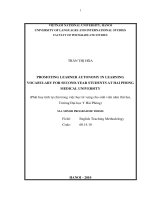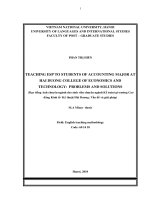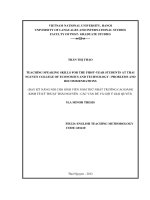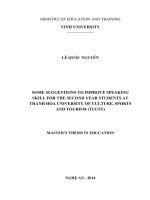Tips to improve listening skill for final year students at hai phong university of management and technology
Bạn đang xem bản rút gọn của tài liệu. Xem và tải ngay bản đầy đủ của tài liệu tại đây (970.62 KB, 43 trang )
BỘ GIÁO DỤC VÀ ĐÀO TẠO
TRƯỜNG ĐẠI HỌC QUẢN LÝ VÀ CƠNG NGHỆ HẢI PHỊNG
-------------------------------
KHĨA LUẬN TỐT NGHIỆP
NGÀNH : NGƠN NGỮ ANH- NHẬT
Sinh viên
: TRẦN THỊ BÌNH
Giảng viên hướng dẫn: TH.S BÙI THỊ MAI ANH
HẢI PHÒNG 10- 2020
BỘ GIÁO DỤC VÀ ĐÀO TẠO
TRƯỜNG ĐẠI HỌC QUẢN LÝ VÀ CƠNG NGHỆ HẢI PHỊNG
-----------------------------------
TIPS TO IMPROVE LISTEN SKILLS FOR
FINAL YEAR STUDENT IN
HAI PHONG UNIVERSITY OF MANAGEMENT
AND TECHNOLOGY
KHÓA LUẬN TỐT NGHIỆP ĐẠI HỌC HỆ CHÍNH QUY
NGÀNH: NGƠN NGỮ ANH NHẬT
Sinh viên
: TRẦN THỊ BÌNH
Giảng viên hướng dẫn: TH.S BÙI THỊ MAI ANH
HẢI PHÒNG 10- 2020
BỘ GIÁO DỤC VÀ ĐÀO TẠO
TRƯỜNG ĐẠI HỌC QUẢN LÝ VÀ CƠNG NGHỆ HẢI PHỊNG
--------------------------------------
NHIỆM VỤ ĐỀ TÀI TỐT NGHIỆP
Sinh viên: Trần Thị Bình
Lớp
: NA1901N
Ngành
: Ngơn ngữ Anh-Nhật
Mã SV: 1512753017
Tên đề tài :Tips to improve listening skill for final year students at Hai
Phong University of Management and Technology
NHIỆM VỤ ĐỀ TÀI
1. Nội dung và các yêu cầu cần giải quyết trong nhiệm vụ đề tài tốt nghiệp
………………………………………………………………………………….
………………………………………………………………………………….
………………………………………………………………………………….
………………………………………………………………………………….
………………………………………………………………………………….
………………………………………………………………………………….
2. Các tài liệu, số liệu cần thiết
…………………………………………………………………………
…………………………………………………………………………
…………………………………………………………………………….
3. Địa điểm thực tập tốt nghiệp
TRUNG TÂM ANH NGỮ AMES HẢI PHÒNG
CÁN BỘ HƯỚNG DẪN ĐỀ TÀI TỐT NGHIỆP
Họ và tên
: Bùi Thị Mai Anh
Học hàm, học vị
: Thạc sĩ
Cơ quan công tác
: Trường Đại học Quản lý và Công nghệ Hải Phòng
Nội dung hướng dẫn: Tips to improve listening skill for final year students at Hai Phong
University of Management and Technology
Đề tài tốt nghiệp được giao ngày 03 tháng 08 năm 2020
Yêu cầu phải hoàn thành xong trước ngày 16 tháng 10 năm 2020
Đã nhận nhiệm vụ ĐTTN
Đã giao nhiệm vụ ĐTTN
Sinh viên
Giảng viên hướng dẫn
Hải Phòng, ngày 22 tháng 10 năm 2020
TRƯỞNG KHOA
CỘNG HÒA XÃ HỘI CHỦ NGHĨA VIỆT NAM
Độc lập - Tự do - Hạnh phúc
PHIẾU NHẬN XÉT CỦA GIẢNG VIÊN HƯỚNG DẪN TỐT NGHIỆP
Họ và tên giảng viên: Th.s Bùi Thị Mai Anh
Đơn vị công tác:
Trường đại học Quản Lý và Cơng Nghệ Hải Phịng
Họ và tên sinh viên:
Trần Thị Bình
Nội dung hướng dẫn:
Tips to improve listening skill for final year students at Hai
Chuyên ngành: Ngôn ngữ Anh- Nhật
Phong University of Management and Technology
1. Tinh thần thái độ của sinh viên trong quá trình làm đề tài tốt nghiệp
..............................................................................................................................................
....... ..............................................................................................................................................
....... ..............................................................................................................................................
....... ..............................................................................................................................................
2. Đánh giá chất lượng của đồ án/khóa luận (so với nội dung yêu cầu đã đề ra trong
nhiệm vụ Đ.T. T.N trên các mặt lý luận, thực tiễn, tính tốn số liệu…)
....... ..............................................................................................................................................
....... ..............................................................................................................................................
....... ..............................................................................................................................................
....... ..............................................................................................................................................
....... ..............................................................................................................................................
....... ..............................................................................................................................................
3. Ý kiến của giảng viên hướng dẫn tốt nghiệp
Được bảo vệ
Khơng được bảo vệ
Điểm hướng dẫn
Hải Phịng, ngày … tháng … năm ......
Giảng viên hướng dẫn
(Ký và ghi rõ họ tên)
CỘNG HÒA XÃ HỘI CHỦ NGHĨA VIỆT NAM
Độc lập - Tự do - Hạnh phúc
PHIẾU NHẬN XÉT CỦA GIẢNG VIÊN CHẤM PHẢN BIỆN
Họ và tên giảng viên:
..............................................................................................
Đơn vị công tác:
........................................................................ .....................
Họ và tên sinh viên:
...................................... Chuyên ngành: ..............................
Đề tài tốt nghiệp:
......................................................................... ....................
............................................................................................................................
............................................................................................................................
1. Phần nhận xét của giáo viên chấm phản biện
...... ..........................................................................................................................................
...... ..........................................................................................................................................
...... ..........................................................................................................................................
...... ..........................................................................................................................................
...... ..........................................................................................................................................
...... ..........................................................................................................................................
...... ..........................................................................................................................................
2. Những mặt còn hạn chế
..........................................................................................................................................
...... ..........................................................................................................................................
...... ..........................................................................................................................................
...... ..........................................................................................................................................
...... ..........................................................................................................................................
...... ..........................................................................................................................................
...... ..........................................................................................................................................
3. Ý kiến của giảng viênchấm phản biện
Được bảo vệ
Không được bảo vệ
Điểm phản biện
Hải Phòng, ngày … tháng … năm ......
Giảng viênchấm phản biện
(Ký và ghi rõ họ tên)
ACKNOWLEDGEMENT
It would not have been possible for me to finish this graduation thesis without
help and support from the kind people around me, to only some of whom I can
give particular mention here.
First and foremost, I am indebted to my supervisor, Ms. Bui Thi Mai Anh for
the continuous support of my thesis, for her patience, motivation, enthusiasm,
and immense knowledge. Throughout my thesis writing period, she provided
encouragement, sound advice, good teaching, good company, and lots of good
ideas. I would have been lost without her.
It is difficult to overstate my gratitude to teachers in Foreign Languages
Department. They build the initial foundation of my knowledge and offer me the
opportunity to complete my graduation thesis.
In my work, I have been blessed with a stimulating and fun environment in
which to learn and grow provided by my many friends. My sincere thanks go to
them for helping me get through the difficult times, and for all the emotional
support, entertainment, and caring they provided.
Last but not least, to my family, I bid them hearty thanks. They have been a
solid anchor on which I rely again and again. Words cannot express how
grateful I am to be in their support and how much this work was enhanced and
made easier by them being in mine.
Hai Phong, August 2020
TABLE OF CONTENTS
PART ONE: INTRODUCTION ........................................................................... 1
1. Rationale ......................................................................................................... 1
2. Aims of the study .............................................................................................. 2
3. Methods of the study ......................................................................................... 2
4. Scope of the study ............................................................................................. 2
5. Design of the study ............................................................................................ 3
PART TWO: DEVELOPMENT ........................................................................... 4
CHAPTER I: LITERATURE REVIEW ............................................................... 4
I. An overview of listening.................................................................................... 4
I.1. Definition of listening ..................................................................................... 4
I.2. The importance of listening ............................................................................ 5
I.2.1. Help yourself be able to understand, empathize with other people ............. 5
I.2.2. Help build relationships with people around ............................................... 5
I.2.3. Create trust with people ............................................................................... 5
I.3. Types of listening ............................................................................................ 5
Casual listening, .................................................................................................... 5
I.4. Listening process ............................................................................................ 6
I.5. Difficulties in listening ................................................................................... 7
I.6: Tips to improve listen sklii ............................................................................. 8
I.6.1 Predict the content......................................................................................... 9
I.6.2 Listen to the gist ............................................................................................ 9
I.6.3 Detect signal words ..................................................................................... 10
I.6.4 Listen to every detail................................................................................... 10
I.6.5 Inference the meaning ................................................................................. 11
I.6.6 Some other ways ......................................................................................... 12
CHAPTER II: METHODOLOGY ...................................................................... 14
II.1. Participants .................................................................................................. 14
II.2 Data collection instruments and procedure .................................................. 14
II.2.1 Survey questionnaire ................................................................................. 14
II.2.2 Data collection ........................................................................................... 15
II.2.3. Data analysis ............................................................................................. 15
CHAPTER III : FINDINGS AND DISCUSSION ............................................. 16
PART THREE: CONCLUSION ......................................................................... 28
1. Summary ....................................................................................................... 28
2. Limitations of the study .................................................................................. 28
3. Recommendations for further study ................................................................ 28
REFERENCES .................................................................................................... 30
APPENDIX ......................................................................................................... 32
PART ONE: INTRODUCTION
1. Rationale
Nowadays, together with growth of global connection, English language has
become more and more important. Especially in Vietnam, learning English
seems to be one of main tasks of students. In this process, they encounter a
large number of difficulties. One of them is listening skill. One of the
aspects in learning a foreign language is listening. Listening plays an
important role in the language learning. It is a demanding process, not only
because of the complexity of the process itself but also due to the facts that
characterize the listener, the speaker, the content of the message and any
visual support that accompanies the message. Listening provides the
necessary input for learners to acquire the language needed for practicing a
language. Listening is the skill that is used most often. It has been claimed
that students receive nearly 90 percent of their school-based information
through listening to instructors and to one another (Schwartz, 1998)and
that more than 50 percent of the time they spend functioning in a foreign
language will be devoted to it (Nunan, 1998). Yet the skill of listening
remains underappreciated; it may be the least understood and most
overlooked of the four skills in the language classroom. Unlike other
language skills such as reading and writing, which can be observed directly,
listening is an abstract, intricate process of hearing, identifying,
understanding and interpreting spoken language. Many students have
significant problems with listening. The speed of utterances, the reduced
forms of natural English, the use of intonation for meaning, and unfamiliar
accents, all take their tools and it is essential to give learners at all levels
plenty of practice. Therefore the choice of appropriate method is a great
significance in developing listening skills and improving student’s overall
language learning. Dictation is one of teaching technique which might be
used for any level. Flowerdew and Miller (2005: 200) defines dictation as a
simple technique that the listener listens to an oral text and write down what
they hear, the passage may be presented more than once and it needs to be
presented in segments or information units.
The focus of this study is to highlight the importance of dictation as a
technique and to prove that this technique has the potential for learners’. The
1
researcher attempts to investigate the effectiveness of using dictation and
eventually foster their listening abilities to become competent and
autonomous listeners. Thus, the topic “A study on dictation method to
improve students’ listening skill” is chosen.
2. Aims of the study
This study aims to explore the role of dictation as a technique in developing
English as a Foreign Language (EFL) students’ listening and: - To
investigate whether the use of dictation as a technique is useful in
developing students listening or not. - In addition to find out how students
would respond to dictation as a teaching technique and to attract teachers’
attention towards the effectiveness of dictation as a technique in improving
listening ability
3. Methods of the study
Considering all the characteristics, this paper made great use of both
quantitative method. A quantitative took full advantage of using the
structured questions where response options are predetermined and a large
number of respondents are involved to explore students’ attitudes towards
their listening skill and their difficulties in listening to English as well as
their expectations to their teachers. In terms of this methods, the
questionnaire is designed as a means for researcher to collect data.
Questionnaires are more convenient, take less time, cheap and easy for
students to answer. Questionnaires included closed and open-ended
questions. The questionnaire is given to students of the second-year students
of foreign languages department. As they are in their second academic year,
they often experience such problems. It is stage that students should be
equipped with variety of techniques right from their early listening. With
appropriate strategies, they will have built up their listening skill by the time.
After gathering all the results of questionnaire with answers, the method of
analyzing data is applied.
4. Scope of the study
The sample of this research was limited to final year students who are
studying English major at Haiphong University of management and
technology . This research is limited to a specific number of students. The
researcher decided to choose 40 students at Haiphong University of
2
Management and Technology. This population will be chosen randomly.
Questionnaires are given out when students finish their class at universities.
5. Design of the study
This study is composed of three main parts:
Part one is the introduction which consists of rationale, aims, study
methods, the scope and design of the study.
Part two is the development – the main part of this paper which is divided
into three chapters:
Chapter I is the literature review
Chapter II shows detailed explanation of the methodology
Chapter III shows the findings and discussion
Part three is the conclusion which summarizes what was given in previous
parts as well as some limitations of the study and recommendations for
further study.
3
PART TWO: DEVELOPMENT
CHAPTER I: LITERATURE REVIEW
I. An overview of listening
I.1. Definition of listening
Listening is one of the most frequently used language skill which plays a
crucial role in communication and in the process of education. For that
reason,
According to Field (1998: 38) ‘Listening is an invisible intellectual process,
so it is difficult to describe. Listeners must distinguish sounds, understand
vocabulary and grammatical structures, understand the speaker’s stress and
intentions, be able to recall and understand it in the socio-cultural context of
speech.
Anderson & Lynch (1988: 21) gives the following definition of listening
comprehension: ‘Listening comprehension means understanding what a
speaker has to say. The listener has a particularly important role in the
listening process by using his diverse knowledge to analyze what he hears to
be able to understand the speaker’s statement.
Wolvin & Coakley (1985) defines listening in a simpler way: ‘Listening is
the process by which the hearing organs receive, process, and identify the
message of speech.
The definition of listening comprehension, according to Van Tan and
Nguyen Van Dam (1997) in the ‘Vietnamese Dictionary’ is specifically
given as follows: ‘Listening is a process in which hearing receives external
sounds and transfers it reaches the central nervous system. Here, these
sounds are analyzed, converted into signals and transmitted to the senses to
help form human’s reflexes to those sounds. ‘‘
The above definitions show that listening comprehension is a complex
problem-solving skill. The task of listening comprehension is not only to
receive the sound, it also requires analysis and identification of the message
of the word.
In summary, listening took on various definitions depending on different
purposes of authors. On the other hand, they all establish listening as a
crucial skill that have to be mastered by EFL students to increase their
4
ability to grasp words correctly in order to be good listeners that help them
to realise success in communication with others.
I.2. The importance of listening
First of all, it is necessary to mention the role of this type of skill in normal
human life, in activities with friends and relatives.
I.2.1. Help yourself be able to understand, empathize with other people
If listening only helps you to know what others are saying, then listening
will help you to understand them. In order to be able to listen and understand
the speaker’s heart, it is not easy. That’s why listening skills need to be
practiced.
Parents understand their children, whether the boss understands the staff or
not depends on listening skills. To be successful in your career as you want
to learn a foreign language well, you must know how to listen to English
communication or to have a happy life, you need to know how to listen.
I.2.2. Help build relationships with people around
Thanks to the role of understanding, not only listening to communicative
English, but also listening to common skills helps to build and develop many
different relationships.
Knowing how to motivate and help others will make your relationship
stronger. You can also easily establish a new relationship by listening to the
other person’s story.
I.2.3. Create trust with people
Certainly, when you have listening skills, you will make others trust you
more, want to talk to you more. This will both help you to make more
friends and help you do your job well. You want to entice customers to use
your product and come back to use it. Then you will have to build trust with
your customers through this listening skill.
I.3. Types of listening
Listening skills including of two main types are casual and focused listening
going together, up to the aim of listening (Nguyen Thi Van Lam and Ngo
Dinh Phuong, 2006).
Casual listening
Casual listening, means listening without a particular purpose. When we
listen, we do not pay much or even any attention to the information unless
5
there is something that makes us interested, this leads to a case that we could
hardly remember the content of what we have just heard. In life, we conduct
this kind of listening so much, for example, when we listen to music, or
listen to news on the radio or TV while doing some housework or chatting to
a friend.
Focused listening
Focused listening, like its name of this type, it contrasts to casual listening,
that is when we listen something in a concentrated way with a specific aim
of finding out and gathering information that we are in demand. For
instance, we use this kind of listening in the class, in the meeting or in a
seminar talking about topic that we are interested.
I.4. Listening process
Listening process divides into five periods:
Receiving
Understan
d
Responding
Remembe
r
Evaluating
Receiving
It refers to the response caused by sound waves to the ear of listener. It is the
physical response. Understanding At this stage, you learn what the speaker
means through the thoughts and emotional tone. It is crucially important to
communication process and exists in all speech.
Remembering
Remembering is needed for maintaining conversation because it means that
a message has not only been delivered and interpreted but also added to the
listener mind’s storage bank.
Since human is moral and our attention is selective, it caused that while we
are in conversation, just some of information are collective in our internal
memory. Consequently, what is remembered might be quite different from
what was originally seen or heard.
6
Evaluating
This stage is mostly executed by conscious awareness, consists of judging
the messages in some way. Meanwhile, you might try to penetrate the
speaker’s underlying intentions or motives.
Responding
In the conversation, with the aim of informing to speakers, whether the
message has been received, the listeners have to send a feedback through
verbal or nonverbal method. That is necessary for prolonging the
conversation.
In conclusion, listening is the psychological process of receiving, attending
to, constructing meaning from, and responding to spoken or nonverbal
messages (Syed Arif Ali Shah - Published on Jul 5, 2010).
I.5. Difficulties in listening
It is quintessential to acknowledge that listening can be quite challenging,
mainly for young rookies. When supplied with a new language,
inexperienced persons attempt to apprehend it in terms of cues of their first
language (Cameron, 2001), which is still in a growing technique itself. As
human beings aren’t always communicating face-to-face listeners cannot
expect the verbal exchange because there is no visible guide, nor can they
ask someone to copy or try and provide an explanation for it in a different
way, for example, while you concentrate to a cd. For that reason, listening is
regarded as one of the most tough competencies to learn and therefore to
educate (Subject, 2008) because of the reality that listening is pretty
complicated and calls for an active process of interpretation wherein
listeners must attempt to understand the messages they pay attention with
using the expertise they already possess (Rost, 2002). Further, they cannot
manipulate the selection of vocabulary, structure or rate of conveyance of
the speakers. As language instructors we must additionally ensure that
children are aware that regardless of their best attempt, at times, they will
nevertheless stumble upon some problems and challenges as improving
listening is a process that requires time and exercise and that they’re not
predicted to recognize each phrase on every occasion that they’re asked to
do listening activities (Brewster, Ellis & Girard, 2002).
According to Bloomfield et al. (2011), there are some other elements
concerning the traits of the listeners that can additionally have a main impact
7
on their capacity to hear efficiently. Namely, listeners’ working memory
capability which is mirrored by using their capability of understanding more
of what they hear when they are listening to L2 (A person’s second
language) language. In addition, more than a few of factors pertaining to
listeners’ enjoy with the l2 impact their listening talents, which include the
amount of publicity to the language, familiarity and ability to apprehend the
phonology of the goal language, the quantity of vocabulary supplied and
history information approximately the subject.
Bloomfield et al. (2011) also claim that it is necessary to be aware that
listeners’ nervousness affects their capability to apprehend what they can
hear, specifically young newbies who have a tendency to succumb to
distractions every now and then and are unable to focus their attention for
long duration of time on the same activity, which makes it even extra
difficult for them to hear efficaciously. Therefore, we ought to strive to
maximize our students’ getting to know capacity in class thru listening
(Rivers, 1981) as this ability is the first segment that connects language with
that means. Furthermore, speaking, proceeds listening cognitively
(Bozorgian, 2012) as a consequence, listening affords the input that
resources the premise for language acquisition and lets in beginners to
interact in spoken verbal exchange.
I.6: Tips to improve listen skill
It’s not hard to realize the importance of listening when research shows that
it takes up 45 percent of the time adults spend communicating. This is
significantly more than speaking at 30 percent, and reading 16 percent with
writing only nine percent.
However, in terms of its importance, students (and even teachers) often do
not pay attention. But notice that listening is the most challenging of all
English skills.
There are many difficulties that an individual may face in understanding a
conversation, lecture or conversation in their second language (and
sometimes even in their first language). The speaker and the listener’s
objective situation can be the cause of these difficulties.
The above objective factors include fast speaking speaker, noise, lack of
visual clues (such as speaking on a phone), limited vocabulary of listeners,
lack of knowledge of the topic and inability differentiation of sounds.
8
While challenges caused by speakers or objective circumstances may be out
of the listener’s control, there are several skills or ‘strategies’ that English
learners can use to assist.
I.6.1 Predict the content
Imagine you just turned on the TV. You see a man in a suit standing in front
of a large map with symbols of sun, clouds and thunder. Do you imagine
what he was going to say to you? Most likely, this will be the weather
forecast. You can hear words like ‘sunny’, ‘wind’ and ‘gloomy’. You will
probably hear the use of the futuristic tense: ‘It will be a start to a cold day’;
‘it will rain in the afternoon’.
Depending on the context - a news, a lecture on a university lecture, an
exchange in a supermarket - you can often predict the kind of words and the
type of language the speaker will use. Our knowledge of the world helps us
predict what kind of information we may hear. Furthermore, when we
predict the topic of a conversation or a conversation, all the related
vocabulary stored in our brain is activated to better understand what we are
hearing.
Practice: Watch or listen to recorded TV shows or clips from YouTube,
pause after every few sentences. Try to predict what will happen or what the
speaker might say next.
Tip: If you’re taking a listening test, go through the previous questions and
try to predict what kind of information you need to hear. A question begins
with the phrase ‘How many…?’ may ask you to listen to a specific number
or a certain number.
I.6.2 Listen to the gist
Imagine you are a superhero flying in the sky. From that height, we can see
what the whole area is like, how densely populated, the type of housing in
each area. When listening, you can also get the ‘whole image’ but with one
important difference: the information comes in a string. And in that chain of
information, there are content words (nouns, adjectives, and verbs) that can
help you form the picture. We often call this gist listening.
For example, the words ‘food’, ‘friends’, ‘fun’, ‘park’ and ‘sunny day’ have
9
their own meanings, but when you hear the words in order, they help form
the scene. of a picnic.
Practice: Find a short video with subtitles on a topic that interests you. Use
headlines to help you predict the content and then listen to the content
words. Go back and listen again with subtitles. How many parts did you
understand when you first heard? Try again in a week.
Tip: As you learn new words, try grouping them with other words used in
the same context. Mindmap is very useful in this case.
I.6.3 Detect signal words
Just like street traffic lights, there are verbal signs that help us keep track of
what we are hearing. These words, connect ideas, help us understand what
the speaker is talking about and where they are saying. They are especially
important in presentations and lectures.
For example, if a university lecturer says: ‘I will talk about the three factors
that influence global warming ...’ then you might hear the phrases ‘first’,
‘move on’ and ‘summary’ to indicate the next part of the talk. Other words
and phrases can work in a similar way. For example, for clarification (‘in
other words’, ‘to put it in another way’); to give examples (‘to illustrate
this’, ‘for example’).
Practice: Most English language learners come with a CD and dialogue.
Find examples of business presentations or lectures and see how many
signaling phrases you can identify (listen more than once if needed). Then
check your notes and compare them with the dialogue.
Tip: In your notebooks, signal phrases should be grouped by function and
added new idioms as you come across them.
I.6.4 Listen to every detail
Imagine you’re a detective scrutinizing buildings you’ve seen before like a
superhero. This time, instead of getting into the big picture, you’re looking
for something specific and don’t care if anything doesn’t match what’s on
your list. Similarly, when listening to detail, you are interested in a particular
type of information - perhaps a number, name or object. You can ignore
anything that is not relevant. This way, you can narrow down your search
and hear the details you need.
10
In a listening test, if you are asked to write a person’s age, listen for words
related to age (‘old’, ‘young’, ‘year’, ‘date of birth’, etc.) or a number of
words can represent the person’s age. If that was conversation, you could
wait to hear someone initiate the question with the question ‘How old is ...?’
Practice: Choose a type of insights you want to practice listening to and
watch the programs for which you wish to receive that information. For
example, you can listen to a weather report for details of the weather, or you
can follow sports news to find the latest results.
Tip: If you’re taking a quiz, as soon as you get a paper question, flip through
the questions, underline important words and decide what kind of detail you
need to hear.
I.6.5. Inference the meaning
Imagine you are a tourist in a country where the language you do not speak.
In a restaurant, you hand over a credit card to pay the bill, but the cashier
seems to be saying something sorry in response. Even though you don’t
understand what they’re saying, you can conclude that the restaurant doesn’t
accept credit cards and that you need to pay with cash. This is meaning
inference technique: using the clues and knowledge about a situation to find
out the meaning of what we hear.
Likewise, we can guess the relationship between people and the words they
use, without having to figure it out directly. Conduct the following
conversation:
A: Tom, have you done your homework yet?
B: I did, but the dog chewed it up.
A: That’s a bad excuse. I will never pass the test without studying harder.
We can deduce from using the words ‘homework’ and ‘tests’ that this is a
conversation between a student and his or her teacher. By using our
contextual clues and our knowledge of the world, we can figure out what is
being said, who is talking and what’s going on.
Practice: Find a YouTube video about a popular TV show, for example,
Friends. Now, instead of watching it, just listen to the conversation. Can you
make guesses about what’s going on, who’s talking and what is their
relationship? Now listen to the video a second time but watch it as well. Is
your conclusion correct?
11
Tip: If you hear a word that you don’t understand, try to guess its meaning
based on the context or actual situation. Don’t worry if you don’t fully
understand from the first time you listen. The more you practice, the better
you will improve!
I.6.6 Some other ways
Choose easy-to-understand “input”
The most important thing when improving your listening skills is to choose
revision materials that are appropriate for your level, or slightly higher.
These materials I usually refer to as “inputs”.
Everyone’s qualifications vary widely, so there is no universal formula for
everyone. However, in my opinion the understandable input is any sound
source that you can understand at least 60 to 80%.
If you listen to things that you don’t fully understand, you will be easily
disappointed and confused. On the contrary, if you can fully hear and
understand, you will develop a feeling of being subjective, arrogant.
Therefore, a threshold slightly higher than the level, namely 60-80%
listening comprehension is a reasonable choice.
When you listen, you have to try to decode a few words in one paragraph
and another, but will be motivated to find the complete gist. In addition,
your ears will continually cultivate what you already know and absorb new
things.
That’s the first thing I share with Alex. He always chooses movies and
videos that are more difficult than his own level and is disappointed by it. If
he wants to listen to these documents, Alex needs to develop the listening
materials step by step.
Start listening with materials that you know the basics of, then gradually
move into more difficult material as your level increases.
Hear what you like
After grasping method one, you need to find out your favorite “input” to
practice. Although technically you can listen to anything that meets the 6080% standard, it’s ideally suited to interest. This is important because
interest-related “input” will always be more interesting than other material.
If you like what you hear, you will be more motivated to continue listening,
without being discouraged or distracted.
12
That’s why in textbooks there are so many long conversations from getting
to know friends, going shopping or traveling, but you don’t feel like
listening.
Play at speeds
The natives speak very quickly and maybe many of your listening materials
are too slow for the actual speed of communication. They speak so quickly
and fluently that it is difficult for learners to distinguish between short, long
sounds or mentioned content. To be able to speak with native speakers, you
do not need to practice fast listening in the first place because at your level it
will be difficult to learn this material. Instead, at first listen to the material at
a speed suitable for your level, then gradually raise it to the threshold of the
local people. In practice, you can apply a few ways below: When speaking
with one or more native speakers, you can politely ask them to slow down,
or repeat some important words. When listening to a recording, you can play
it back and forth at multiple speeds, from 0.25x or 0.5x. On free applications
like Youtube, Audacity or VLC all allow to adjust the listening speed
depending on your wishes. Out of these options, the second is often more
convenient for learning. Just select any audio file and adjust the playback
speed until you can understand what is being said. Play it a few times at a
slower speed and then speed it up step by step until you get at a native
speaker’s speed.
13
CHAPTER II: METHODOLOGY
II.1. Participants
With the aim of completing the research, the researcher needs a group of
participants called the population of the study. In this study, the students
from second year of Hai Phong University of Management and Technology
were chosen to be the population. The research took randomly 40 students as
the sample of the research. A large numbers of them have learnt English for
averagely 8 years (4 years at secondary school 3 years at high school and 1
year at university). However, their English backgrounds are quite similar
because of being influenced of curriculum of English for high schools
students in the past, students did not have many chances to practice English
skills. Thus, when entering universities, their English levels were limited and
they have to face up with many difficulties in studying. They have
recognized their difficulties, needs, achievement and so on related to
listening activities.
II.2 Data collection instruments and procedure
II.2.1 Survey questionnaire
In the current research, the researcher used a semi-structured questionnaire,
which is easy to be understood by everyone. This questionnaire includes
open ended and close ended questions. The aims are made to give the
opportunity to the participants to present their viewpoints about dictation,
but such questions are infrequently used because some of the weak level
students left it unanswered. This instrument consists of 13 questions divided
into three sections. The first section deals with students’ general
information; it involves one question. The first is about the participants’
years in studying English language. The second section includes six
questions which aims to investigate students’ perceptions of listening, their
level and the difficulties they encounter in listening, in addition to the kind
of activities they practice in the classroom, and their suggestions to
overcome these difficulties. Finally, the last section 15 consists of six
questions. It is the most important part of the questionnaires which inspects
the frequency of using dictation, students’ point of views and perceptions
towards dictation use and their preferences in the classroom, and whether
such technique can bring improvement in their listening or not.
14
II.2.2 Data collection
This section explains all of processes that are related to get information to
find out the solutions for the statement problems. The steps of collecting the
data in this study are as follows:
Explaining about the questionnaires to the students. The researcher
explains the items clearly to avoid misunderstanding.
Giving instruction to the students to fill out the questionnaires.
Collecting the students’ questionnaires.
II.2.3. Data analysis
The next step after the researcher collects the data is analyzing the data.
There are some steps in analyzing the data. They are presented as follows:
Reading and identifying the questionnaires that had been answered.
Classifying the result of the questions
Composing tables to classify students’ problems and strategies used based
on the questionnaires.
Calculating the result taken from the students’ answer based on the tables.
Going to conclusion based on the data analysis.
15
